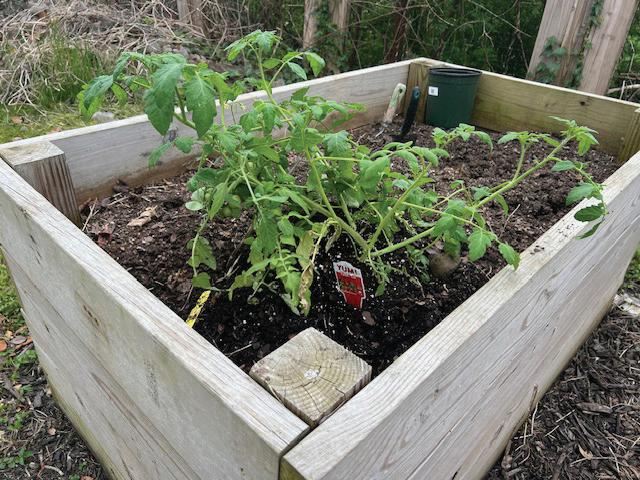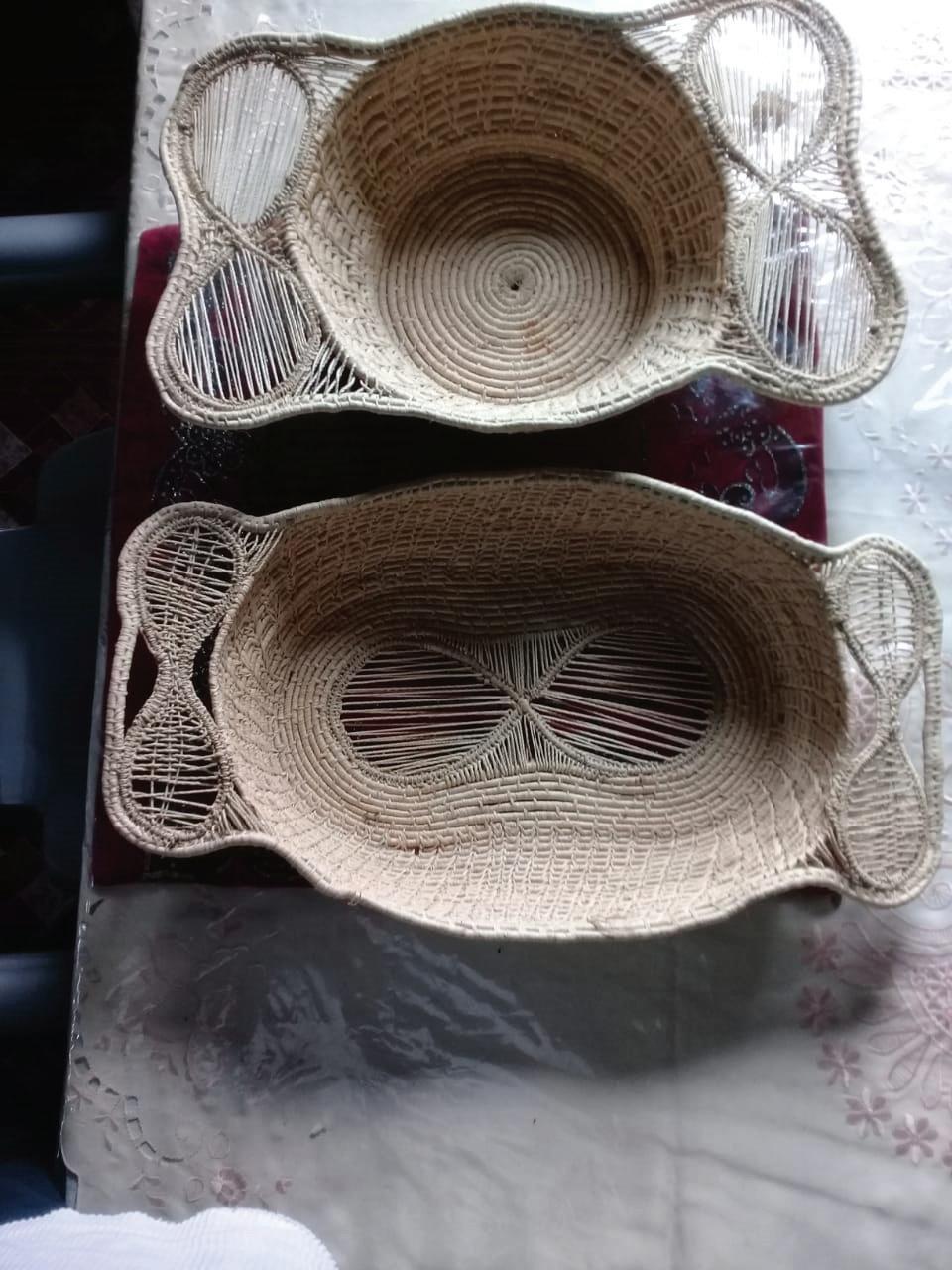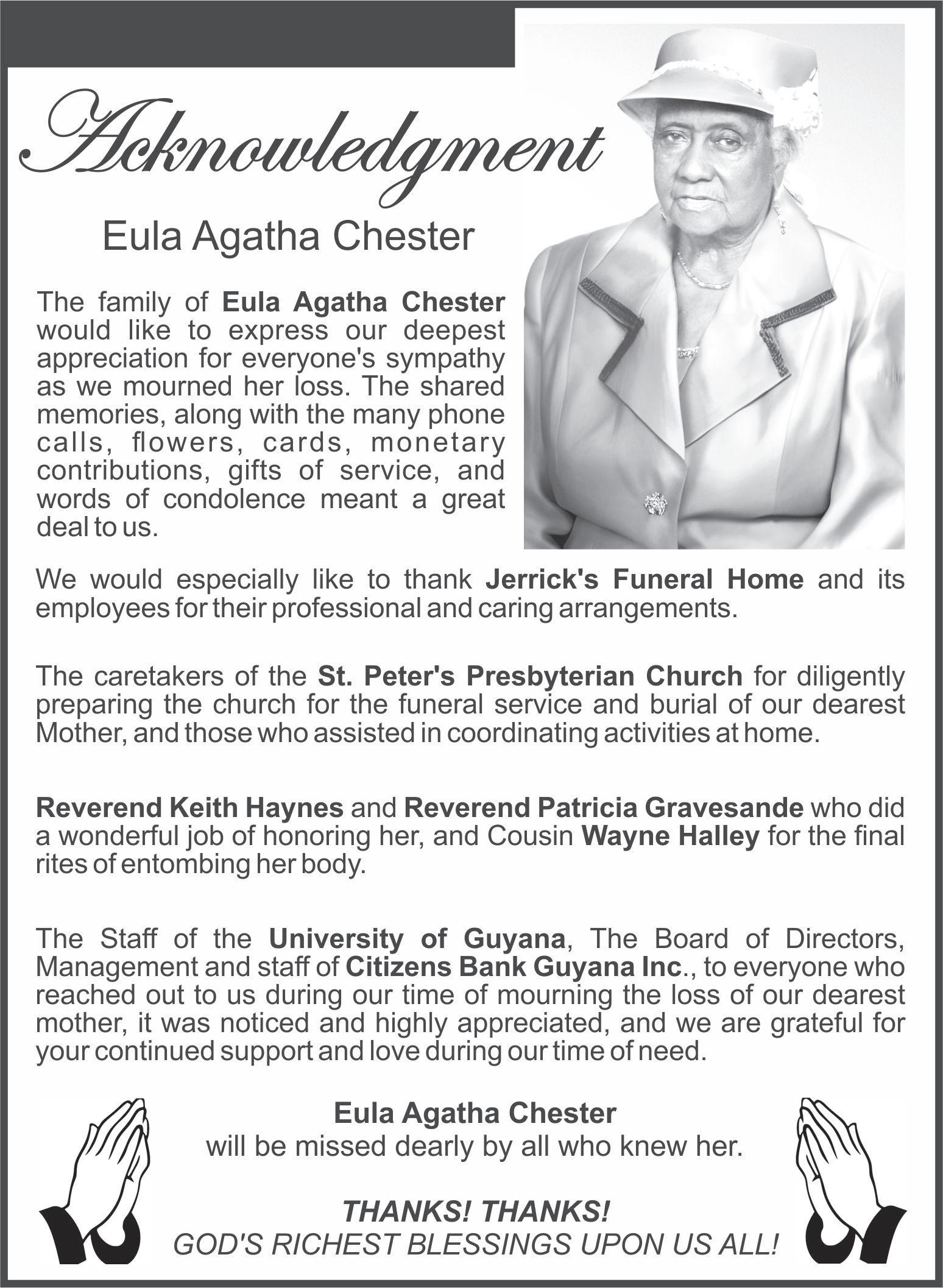Powerful words
How one poet is helping craft her community’s idenity
Sunday, April 14, 2024



Sunday, April 14, 2024


LESLYN Paul’s grandparents were reportedly the first settlers of Imbotero, Region One (Barima-Waini). It was during the days following indentureship, they left the city to seek a better life.
Paul stated that her fore-parents travelled by paddle boat to Region One and found Imbotero Village, where they settled after discovering that there were lands to be farmed.
She added that they made a living by farming, hunting, fishing and cattle rearing. The Pauls came from India as indentured labourers and they, along with others who had made the journey to Region
One, began living in the far-flung community.
Paul reported that most of the early settlers, such as her grandparents, are no longer alive and there are new people in the village these days, Amerindians with a mixture of East Indians and Afro-Guyanese. As a third generation, Paul told the Pepperpot Magazine that, back then, she only attended nursery and primary schools because her parents could not afford to send them to secondary school in Mabaruma. The 50-year-old stated that Mabaruma Secondary School has a dormitory


today, and students from farflung communities such as Imbotero have been allowed to stay in and attend classes, which is commendable.
She reported that, in Imbotero Village, there are six part-time teachers, 10 Community Service Officers (CSOs) and five full-time teachers who earn a government salary. Apart from that, there are no other jobs except for the police outpost and a health post.
Paul added that the nursery school’s building is very
small and has been there for more than 38 years. As such, classes are held only one day per week, but the primary school is functional and has adequate space. Paul pointed out that she would sell her handmade tibisiri hammocks at the Imbotero Research Centre when they have guests, and a hammock takes eight days to complete for just $15,000 per hammock.
She explained that acquiring the tibisiri is tedious and time-consuming and she would have to travel via canoe or paddle boat to the freshwater location away from the village into a small creek.
Paul disclosed that it is about three miles paddling to get to the ite’ palm trees and she would extract the branches to start making the tibisiri, including stripping, washing, boiling and drying. It is then spun into something like a polytene cord and
then knitted by hand for eight days before completion.

Tibisri is a natural strawlike material harvested from
proper care. If wet, it must be fully dried to maintain its texture, says Paul.

the ete` palm and only grows in fresh water.
According to some, the tibisiri hammock can last a lifetime – at the very least, it can last up to 10 years with
Apart from hammocks, Paul also makes hats, fruit baskets, bowls, hand bands,

POETRY plays a significant role in culture. Although an individualistic craft, poetry can give a voice to a people. Rhythmic sentences that tell of your home are vital in creating a sense of pride in one’s identity, origin, and past. This is how Clarine Charles views poetry. The now 60-year-old is a pillar of the community of Bethany. Born and raised in the village, it is the only home she has ever known and the one she continues to represent with her poetic words.
Upbringing and origin.
Sixty years in the village of Bethany has ensured Clarine Charles’ place among the people. She has worked in and around the village all her life and is well-known among the locals. Her words, however, reach further and have a far greater impact. Beginning fresh out of high school, Clarine took on poetry to represent her village of Bethany. Today, her words live on as a part of the community, and they continue to be heard as they work to shape the community’s identity.
Recalling her early days in school, Clarine excelled throughout her schooling, and upon ending her secondary education, she saw poetry as her next endeavour. “Our teachers of the time were really good. They used to teach us. So when we went to write our assessment we all passed. They were very good,” she explained.
After attending Anna Regina Multilateral School, among the best schools in the region, poetry called her. “When I finished secondary school I told myself that I have to tell stories and make my poems,” she said. This decision would have a far greater impact than she could have imagined. Clarine had always had a passion for all things literature; writing her pieces, however, was an entirely different thing. Nonetheless, it is something that she excelled at. Her work began as most poets do, drawing inspiration from her surroundings. Being encapsulated by the striking beauty of Bethany was inspiring and still is. This pushed Clarine to formulate countless stories about her home.
Representing her home with words.
Clarine’s poems are intrinsic to listen to, especially her spoken word. But it is now just her passion and emphasis on performing her poetry that bring her work to life. The enig-
matic poet has spent decades formulating lines and rhyming words in a way that is especially pleasing to listen to while getting each message across. As she stated, “I got my book and I began to think about how to write my poems, how I would form my lines; how I would name the poems; and how I would do it when I am telling the poem. About how I have to be very outspoken and how I have to be very fluent.” To Clarine, poetry is a craft that requires more than pretty words. She describes it as a technical skill as well. She emphasises the significance of voice and the very way the words are spoken. The very words she speaks represent her home.
The conservation of the craft.
Heritage time in Guyana is a big deal for everyone. All across the country, Guyana’s first people came together to celebrate history and culture, which is so rich it is felt in every corner of the country. Amidst the arrows, bows, and food of the occasion, there is craft and creativity. Clarine’s poetic talent is on full display during this time. She has had countless poems about Bethany and what her community means to her, and her words resonate with people everywhere as she speaks of challenges that are familiar to many. Clarine’s favourite poem, however, is one she wrote for her husband, titled, ‘God created you and me.’ Today, Clarine still writes in her


IT was in the interest of keeping her late daughter’s love of assorted desk-sized buddy pots and plants alive that Gloria Jaimotie established a small business ‘Pretty Plants and Thingz’ from her home and that of her daughter, Anita Narine, who was killed in a road accident last December.
Jaimotie told the Pepperpot Magazine that her eldest daughter, Anita Narine, was employed by Cameron and Shepherd law firm as the Secretary, and, on that day of the accident, she was crossing the road to take some plants to a friend.
She was struck down and killed in front of her two children and her mother at Le Destin, East Bank Essequibo, on December 19, 2023. A police report said it happened at about 19:45hrs while Narine who was attempting to cross the road, was struck down by a speeding bus bearing number plate BAD 6362. She was picked up and taken to the Sheriff Hospital at Leonora, West Bank Demerara, but succumbed to her injuries.
According to Jaimotie, her late daughter, Anita, loved plants and she nurtured and prepared desktop-sized plants by the dozens to sell as her side hustle and would drop off plants to customers, friends and others in her spare time.
“My daughter loved that kind of plant, the little ones for your desks. She invested a lot of time, caring and nurturing them and would buy a new one every now and again and had


them by the dozens. She has a lot of these plants,” she said.
So, when she died tragically, they had to do something with the plants to keep her memory alive and they believe she would have wanted that too.
Jaimotie and her other daughter would take turns caring for the plants, and they have some of the plants at her home in Grove, East Bank Demerara, and some at Narine’s home in Providence, as well as on the East Bank Demerara.
The elderly woman related that she is still in a deep state of grief following the loss of her eldest daughter but she has to garner strength to take care of her grandchildren. Narine left two children, ages 25 and 19. The boy is pursuing studies at the University of Guyana (UG). Jaimotie took care of them from babies.

Jaimotie reported that they did not want the plants to go to waste and decided to start a small business in Narine’s honour to sell plants after coming up with a name.
She added that they are currently preparing a Mother’s Day promotion on the sale of plants and she will continue to keep the small business at home.
Jaimotie told the Pepperpot Magazine that these last years have been especially difficult for her after she lost her husband to a heart attack, her only son and a grandson to poison. Both her son and grandson committed suicide.
Then, after losing her eldest daughter, she thought she was going to lose her mind since the road accident happened right before her eyes.
Jaimotie related that she is holding on and is looking forward to attaining the age of 65 years old on April 14. Her daughter had promised to have a big celebration for her as a pensioner, but they will forego all such celebrations given the circumstances.
“I made a shed for Anita, more so for her plants in my yard, a place to store all the plants, she has a lot of these plants, and she loved them, so I will keep her alive in these plants,” she said.
Jaimotie added that she will be making a signage in honour of her late daughter that will be affixed to the plant shed in her yard.
“I will do it, but I have to find the strength yet to go about it, but I will do it soon; I must,” she explained.

AS a country boy growing up in McDoom Village, which is the northern neighbouring village of Agricola on the East Bank Demerara, most of the people did gardening. It was part of the culture of rural British Guiana. The adults and the children found much pleasure in tilling the soil and planting a wide variety of cash crops. Among them were bora, okra, bolounger, squash, tomatoes and others, which were the more popular ones.
The agricultural efforts of those small farmers resulted in practical solutions for their limited financial status. Most of the working people of the day, including government workers such as teachers, nurses, postal workers and those employed in other government departments, received rather small salaries in those colonial years. While there were the self-employed, such as carpenters, joiners, and painters, the majority of the residents of McDoom and Agricola were employed at low-paying jobs. As such, receiving what was usually a meagre income, the majority of the people of the two villages lived a simple life. Some were even living what was referred to as a “hand-to-mouth” existence.
Most likely, because of their financial situations, the people of McDoom and Agricola, who had sufficient yard space made a kitchen garden a necessary project. Most homes had gardening tools such as cutlasses, forks and spades. Property owners, and even those who were renting, possessed everything which was necessary and useful for working in the fertile soil and reaping the rewards of their efforts. Back in those early years of my existence, I learned from the older folks who taught the younger generation by doing and showing. They demonstrated in practical ways.
It was a culture. Their practical teaching style demonstrated to the children how to partner with the soil, which produced bountifully when done the correct way. An important element is knowing where and when the right crops are planted. There is, of course, the challenge of floods. Here is where some anti-flood elements should be included, such as raised boxes, as is shown in the accompanying photograph. Of course, there is a cost factor to that, but it will be a good investment. The rewards are much


more guaranteed. Being engaged in kitchen gardening while attending primary school, was a most wonderful extracurricular activity. After all these years, I still re-

A SLOW drifting boat ride down the Supenaam Creek, under a canopy of trees that creates a peaceful atmosphere, leads you into
Amerindian missions in Region Two. With over 400 people, Bethany is well known, but very few take the trip to experience the
Blackwater creeks, white sandy beaches, and vast savannahs give Bethany a picture of serenity. This week the Pepperpot Mag-

the village of Bethany. A village with a unique name and origin, the riverine area is one of the oldest
community. Many know of the village as an indigenous community in the creek, but Bethany is far more.
azine ventured into the hidden gem, with hospitable people and untouched natural beauty. Bethany is




an escape that is very close to home, and more Guyanese should experience it.
Bethany is one of the many indigenous communities in Region Two. Venturing into the mission requires a few hours of travel.
Leaving Georgetown, eager adventurers cross the Demerara River towards the
port community of Parika. From here, one may venture across the majestic Essequibo River either by steamer or speed boat. Whereas the big boats make for a relaxing trip, speed boats offer an exhilarating quick trip over the water. Once landing in the captivating community of Supenaam, this is where the true adventure begins. Travellers stopping in Supenaam use the village as a pitstop before going further inland. Boats leading into Bethany can be found along the Supenaam stelling. Once boarding a Bethany boat, the true nature of the creek and community can be seen from the water.
Laying along the banks of the Supenaam Creek, the village of Bethany covers several miles. Because of the prominence of logging and agriculture in the region, the river is lined with sawmills and farmlands. A vast assortment of homes can be spotted before entering what villagers call ‘the heart of the mission’. Bethany’s boats turn off the boat route towards the mission.
Traversing through the nar-
row waterway to the village opens up an entirely new way of life. Along the banks where people have made their homes are children swimming and others venturing out to school by boats, while mothers use creek water to wash or perform chores. The centre of Bethany is a vision of beauty. A stelling is surrounded by the village’s logging concession health centre and information hub. Bethany is an undeniably majestic place that is still seeing development.
The story of our tour guide
Bethany is home to some of the most welcoming people the Pepperpot Magazine has had the pleasure of meeting. Among its 400 people is Zelisa Wilson. The vibrant and jovial 18-year-old was born and raised in the community, and she describes it as the definition of peace.
Although she had visited along the coast and attended school in Aurora village, Zelisa has experienced the differences that come with
CHANGE is everywhere. All across Guyana, development can be seen in every region, community and by extension, every home. The biggest displays of change lie in the development of far-flung communities. The Amerindian mission of Bethany is one of those villages that has come a far way. Beginning as a small Adventist mission, Bethany has evolved into a highly sought-after escape and burgeoning tourism hotspot. Its people play an intricate role in the development of the community.
“Bethanians”, as they are referred to, are hospitable and proud people. To the people of the creek, their home is as much a part of their identity as their history. For many years, they have dedicated themselves to building their home. With logging and farming being the biggest economic players, the village has retained its sustainable way of life. But to the people of Bethany, sustainability goes hand in hand with development. They vow to shape their community into a beacon that balances tradition and change.
Culture and hospitality
Rhonda Grant is a proud lifelong villager of Bethany. The welcoming nature of the people has always been the village’s most cherished aspect. A deeply traditional indigenous community, Bethany showcases its culture unapologetically at every opportunity. Whether it is during the celebrations of Heritage Month or to any unsuspecting visitor, Bethanians are always happy to share a few words about their community, origin and culture. The village has seen an influx of visitors and tourists in recent times. Many people have praised the community for its authentic and loving nature. Rhonda believes that is one of the things that distinguishes her home from the rest. As she shared during her interview, “Our community is a peaceful community. It is a community where members would share with each other and come together for church services.”
To newcomers and those venturing into the community, the overwhelming hospitality may come as a surprise. To the locals, however, this is just a way of life. As Rhonda further added, “The community does humanitarian work for each other and with each other. It is a loving community.” The welcoming characteristic of the village creates an ideal getaway. This is perhaps why the community leaders have been working towards developing tourism in the region. The toshao and the council built a guest house, the first ever of its kind. According to the council, the guest house is soon to be up and running in addition to several other tourism-based endeavours.
The way leading into the community of Bethany is characterised by numerous sawmills. These economic powerhouses are integral to the way of life in the region. Most of the region’s people see logging as a means of survival. There are a few reasons why logging and lumber are so active in the region. Being lucrative is among the biggest reasons. A quick flight over the village of Bethany would reveal the community’s surroundings. It is situated in deep forest. This makes finding lumber easy, and with the close waterways, transporting both lumber and workers is as easy as could be. As Rhonda shares, “In terms of work, most people here do logging and farming. There are also other work that people do.”
Although agriculture and logging account for a large percentage of the village’s economy, there has been a recent influx of a series of professions. As much as traditional carers are still very prominent, villagers, especially the younger generation, have taken on newer endeavours. Bethany’s ambitious young people have entered into fields such as medicine, health work and community development. “We have teachers and people that are community workers. People in the community depend on these persons. The

services are easy to access, and because of the distance to the coastland, it is better for us.” Although education and health are not entirely new implementations in the community, they have grown recently. This has resulted in new teachers and healthcare workers, many of whom are persons from Bethany.
Rhonda is among the professionals in Bethany. With several years of teaching under her belt, she has also played a role in the development of the education sector of the community. She began her career in 2004 and later advanced to become a teacher at the Bethany primary school. Over the years, she has seen numerous children advance from Bethany’s school towards higher levels of education. As she shared, “I went to Cyril Potter’s College in 2005,
and then I came back to serve in the community because I really wanted to serve my community.” Her
Getting off of the boat at Bethany, there is a sign welcoming visitors.
passion and undying love for her home are mirrored by her fellow Bethanians. To those thinking about
taking a trip to Bethany, the people say it’s a great place to visit but an even better place to call home.


IT is said that if we look hard and long enough, our past holds the key to our future. This is a sentiment the people of Bethany live by. As one of Region Two’s oldest Amerindian communities, Bethany has preserved its past. Moreover, the community has been dedicated to moving in an upward trajectory. Much of the village’s history could be found safeguarded by the village’s leaders.
Sonia Latchman, the current Toshao of the community, shared some background and history about the village. The name ‘Bethany’ is of a Biblical origin, meaning “House of Figs”. The name was given by the Vanlange family who first occupied the area around the 1920s. They were Seventh-Day Adventist Christians. Mr. Vanlange leased this area from the then-British Guiana Forestry Commission to participate in logging activi-
ties. During this period, there were two houses in Bethany owned by Mr. Garvan Vanlange and his brother-in-law Mr. Jack Fiedtkou who later became the church’s leader. As a businessman, Mr. Vanlange employed Mr. Morgan and Mr. Cobis. Today, the community’s boat landings were named after those men. The village council has managed to retain family records from decades ago. Most of Bethany’s native people originate from just a few families. Families were living across the savannah at the time, the Patons and
the Jacks. There were also the Wilsons and Russells. In those days, just a few people were living along the creek.

Before this period, there was a settlement at the mouth of the Essequibo River in a village now known as Airy Hall. The community’s population was later impacted when an epidemic struck the settlement, and many people died. Bethany was established as a community in 1969 and the people obtained the Certificate of Title to their land on October 29, 2010.
cording to records, the community has a unique sense of community. Whenever farmers reaped a good harvest, they would share their produce in the community. Cutting farms was never an issue in those days. People would come together to cut farms and pull logs with what they called a ‘Muster’. After the work is completed for the day, the person who they worked for would sponsor the meals.
influence grew and technology emerged, these practices were done away with. As machinery was brought into the village, production increased. The village benefitted greatly from forest products. Although the forest is depleting, the village was able to acquire a lease from the Guyana Forestry Commission, which may soon become the village extension.
Future endeavours for
neurship in the community.
Dave owns a boat service, and he wears many hats. As a business person, one of the biggest developments in Bethany has been economic growth. With new resources, work in the community has come at a lesser cost. As Dave explained, “The economic situation has greatly improved because of the finance we got from the government for things like the tractors. We also have new

Bethany’s nature of sharing is truly tradition. Ac -
After such hard work, they usually celebrate with fermented cane juice or some other fermented drink. They may have music supplied by singers and guitarists, which will go until the wee hours of the morning. As the church’s

In a community greatly dependent on agriculture, such as Bethany, tractors are a must. The village has designated tractor drivers. Among them is Councillor Dave Rajkumar. With his mom from Truly Island, Dave settled in the community at a young age and has grown up in the village. “I came here from the age of six. From then to now, it is now much easier. I would say that there are a lot of improvements,” he stated. Dave is also a true reflection of entrepre-
boats, a pontoon.”
The addition of boats, tractors and pontoons has greatly impacted the economic situation of the community. The council has some big plans slated. As Dave explained, Bethany is now home to a women’s group that is working on preserving traditional Amerindian crafts. Tourism, travel, health and education are all things that the village has plans for. Wells, more public health buildings and improved infrastructure are just a few.
Dave shared that his community is just one among the hundreds of villages set on carving a path for themselves and are dedicated to doing so little at a time.
How one young woman from Bethany says her upbringing shaped her
By Shaniya Harding.LIFE across Guyana varies from place to place. Each community has its own unique cultural and regional traditions and ways of life. Everyone’s childhood is unique, whether it is the fast-paced nature of life in Georgetown or the serenity of living along the Cornetyne. The creeks and vast forest of Bethany present a refreshing atmosphere. Tucked miles away in the Supenaam Creek, life in Bethany is defined by traversing waterways
wards preserving the flora and fauna she knew as a child. Constantly immersed in the natural beauty of her home, Bethany’s natural diversity never went unnoticed by her. Today, she attends the Guyana School of Agriculture with the ambition of entering the veterinary field. Bethany is highly praised for its untouched reservoir of natural resources. Jemima seeks to keep it that way.“I would describe Bethany as a peaceful, quiet community. It is a close-knit community, and the people get along well,” she said during her

like roads in a community where logging and agriculture are a way of life.
Jemima Wilson was born and raised in the village of Bethany. The surrounding forest and the sounds of nature are familiar to her. Jemima says her upbringing in Bethany did more than impact her; it shaped the person she is.
Growing up in a village where nature reigns supreme, Jemima aspires to work to-

many days filled with exploration deep among the trees surrounding the Supenaam Creek. Bethany’s children have truly unique experiences of living amidst Guyana’s beauty. The 24-year-old began her education in the village. She attended Bethany’s nursery and then primary school. From that point on, she ventured out of the village to further her education.
mentation of boating services, the village is striving towards better accessibility and has already done so with boats designated for the village’s children. This is a recent endeavour however and Jemima had to find alternatives during her years of schooling. As she explained, “I went to school on the Essequibo coast when I stayed at the dorms for five years, and I attended Aurora secondary school.”
ey.” Finding employment fresh out of high school is a challenge many young people can relate to. However, coupled with the uncertainty about what she wanted to do, Jemima spent a few years developing her skills and exploring opportunities outside of Bethany.
interview with the Pepperpot magazine.
Jemima’s childhood seems more reminiscent of a summer holiday, filled with swimming, climbing trees and running through the forest. “Growing up in Bethany was truly nice. There are a lot of fun times I could remember. We have a lot of creeks, so we normally swim a lot and we enjoy the outdoors and the adventures in nature.” Jemima remembers
Challenges with travel are among the biggest woes people of the community express. It is still a big issue the village’s council is working on resolving. With the imple -
Although her years in high school were memorable, and she yielded great results, she remembers missing her family. Being away from her family for the first time was stressful and created a lot of uncertainty for the then-young Jemima. She explained that, “The most challenging thing about going to school on the coast was being away from home. I had to stay in the dorms because of the transportation mon -
In 2022, a few years after graduating from high school, Jemima was still unsure about what her future entailed. “A couple of years passed since I graduated from high school. I did some training here and there. But I was thinking about something that I really wanted to do.”
Jemima further added that she sought out something for which she truly had a passion. “I realised I love and have a passion for plants and animals.” This realisation sparked her ambitions to become a veterinarian. However, although she had the passion and drive, there was still much that had to

be done in order to enter the field she aspired to be in. “I love animals and I wanted to become a vet. But when I applied, I did not have the subjects they wanted. I was told a diploma in agriculture would be good. It deals with both plants and animals, and I love both. So I decided to go for it.”
Jemima is in the final stages of completing her diploma. She returns to her village of Bethany at every opportunity. Most recently, she returned during the Easter holiday to help support her family by working in the community. She has big hopes for the future, and her family supports her decisions. Despite the countless animals the village has, Bethany currently does not have a veterinarian. From pet parrots to lizards, animals are spotted in every corner of Bethany.
Jemima believes that, to some extent, growing up in Bethany played a big role in her love and appreciation for animals. Growing up immersed in the beauty of Bethany and venturing outside to see how that beauty could be destroyed made her appreciate her home and gave her the challenge of preserving the pristine aura and captivating wildlife Bethany had given rise to.






HE stood on the wharf, a sapodilla brown man just over middle age, his black shoulder-length hair with strands of grey tied in a ponytail. On his face was etched the rough years of sea life, and each wrinkle most likely had a story to tell.
“Aye, Ram,” one of the fishermen getting his boat ready called out to him, “All yuh boats goin’ out dis trip?”
“Yeah,” he answered, “All ah dem fit and ready.”
“You going wid any?”
“Nah,” he answered casually.
“Old man retiring?” another fisherman queried.
“Not old, buddy,” Ram assured them, “Ah bin doing dis ah long time and now is time fuh meh sons tuh tek ova dis business.”
He could still remember his first morning on the fisherman’s wharf as a fourteen-year-old. It had been biting cold, sunlight still hours away, as the wind blew in from the Atlantic. His face felt numb, and his
body shivered under the thick jersey. But his young heart had pounded excitedly as they got ready to cast off to sea. His father had held him by the shoulders and said, a proud tone in his voice, “Dis is it, son, yuh maiden trip.”
Ramesh, the boy, had taken a deep breath, thrilled in that moment but nervous for he was standing amongst men with coarse voices, the cussing and shouting drifting with the heavy cigarette smoke.
That was forty years ago.
A long way he had come, from a poor family when life had not always been kind. The family had not shifted much from a poor status over the years be -

cause the father had made a surprising decision to invest more in Ramesh’s younger brothers’ education.
“Ah don’t want all meh sons to be fisha man,” he

had said, “Education gon open doors tuh different opportunity.”
“Not ah bad idea,” Ramesh had thought, though he was the one bearing the brunt of the hard work to supplement his brothers as his father grew older. His mother, a kind soul with a cheery smile, planted a vegetable garden and sold her produce at the weekend market. It was a small income that went a long way with putting food on the table. Their collective selfless sacrifices were rewarded when Ramesh’s second brother, Naresh graduated with a distinction in mechanical engineering. He was offered a high paying job in a private company in the city.
“And dis is how we gon grow from small to big business,” the father explained proudly.
Two years later, the youngest son, Suresh, graduated with top honours and was offered a scholarship to the United Kingdom.
The father had felt a great sense of satisfaction for he had invested wisely and knew he could now retire for his younger sons would continue the family’s legacy
but it did not happen the way he had foreseen.
Ramesh continued to go out to sea, for fishing had become his life and livelihood. Naresh soon opened his own company but an unexpected change began as he gained greater success and his wealth grew. He hardly visited his old home and village and was always busy whenever his mother and father visited him. They became worried and the father had asked one day, “We losin’ we son tuh money and status?”
It seemed that way, and when he married a girl from an upper-class influential family without his family’s blessings, it created tension. Words were not needed to help them understand that Naresh had turned his back on his family and had adopted a new lifestyle.
“Is being poor such ah sin?” the father had asked.
He now became fearful that Suresh might do the same, and his fear was realised not long after.
After graduating, Suresh took a job in Europe, travelling to different parts of the world, never visiting his old home, and just sending small
monetary assistance from time to time.
The mother lost her cheery smile, and the father asked in bewilderment, “How dis happen? Wah we do wrong?”
For the first time, Ramesh had seen his father cry and he had held him gently by the shoulders to comfort him as the old man expressed with regrets.
“Ah sorry son, fuh wukkin’ yuh so hard to help wid yuh brothers, now ah don’t have much tuh give yuh.”
The father’s pain had brought tears to Ramesh’s eyes, and he had said to him, “Yuh did what any good fadda woulda do fuh dem children.”
Today, on the cold morning, standing on the wharf where the old boat he had inherited from his father had so often docked for repairs, he was now the owner of three modernly equipped fishing vessels.
A ‘Big Ben’ Raleigh bicycle that was his father’s, Ramesh had ridden for several years but now, as the fishing boats set out to sea, he walked over to his Toyota Hilux and drove home.
The remarkable thing about him was that after gaining success and wealth, he did not turn his back on anyone with less. He felt the struggles and cried the tears, so he continued to live a simple lifestyle in the village. The old house he inherited from his father he had replaced with a splendid mansion. A poor man from the crumbs of life, now living in luxury.
His brothers, whom he had worked tirelessly for, which helped them gain the successes they have now, neither visited nor called him. It was as though, after the passing of their parents, he did not exist for them.
FROM PAGE VI
life in Bethany versus that of life along the coast. As she stated, “We are a peaceful and quiet community. A place where people share love and communicate with each other. As a community, we are an Adventist community. We mostly go to church and the youths coming up now do church activities.” She further added that the people of Bethany are always ready to welcome visitors and to share the experience of their home. “We encourage people to come into the village and [we can] show them how Bethany is:- quiet and peaceful.”
Although a peaceful haven, life in Bethany presents some challenges because of its location, schooling for the community’s seventy children is difficult.
Children leaving the community traverse the Supenaam Creek at five in the morning to reach school on time, which Zelisa says was just one of the schooling struggles in Bethany. As she shared, “The challenging things about my schooling were transportation and travelling. Every day to travel from home by boat and then by car on the coast, it was very challeng-
ing.” Today, the community boasts its own primary and nursery schools. This has more of an impact on the community than most would think. Bethany’s hundred or so learners are now closer to home. Zelisa is among the unfortunate few who did not get an opportunity to finish her education due to these challenges. She is, however, very happy to see her fellow villagers grasping a better chance at education. She shared, “I did not get to end my education. But as for now, it is easier to go to school. The government has provided transportation for the children too, which is the school boats.”
This has not stopped her ambitions, however. Throughout the Pepperpot Magazine’s visit to the beautiful community of Bethany, Zelisa played the role of tour guide. Her genuine love for her home underscores her vast knowledge and understanding of the village.
Growing up in Bethany, Zelisa stated that during her trips to other places in Guyana, Bethany’s beauty was something that she always saw as unique and utterly refreshing. Zelisa works in the community


One of Bethany’s many creeks
and often plays the role of tour guide, showing appreciation and understanding of the vast riverine area. Today Zelisa is embarking on a new mission. After the years she dropped out of high school, she focused on furthering her education and capabilities. She has undertaken training as a tour guide, among other ventures. Her true passion, however, is nature, making becoming a forestry officer her next big step. She shared, “Right now, I am a community service officer from the village and I like it. As I further my education, I want to become a forestry officer.” Zelisa is also a passionate advocate for her community, as she and her fellow villagers open up their homes to anyone willing to take the adventure.












IN life, there will be challenges. I’ve frequently mentioned the yin-yang theory to highlight that we cannot endure good things in life without “bad” ones happening as well. It’s just the way things are. There will be adversity, whether it be sickness, death, or financial loss. How, then, do we overcome them? A key to overcoming adversity is the ability to be resilient. People often talk about the “bounce back” from challenges. That very phrase is what is used to describe the act of resilience. In science, a “resilient” material can return to its original shape or state after being stretched, bent or twisted. Similarly, a resilient human being can remain flexible. Resilience

refers to the act or process and the successful outcome of dealing with a challenge or difficulty.
The American Psychology Association recognises it and states that it is the mental, behavioural or emotional ability to be adaptive to internal or external factors. Being resilient does not happen on its own. You need a strong set of skills and motivation to do so. Resilient person are able to confront life’s challenges, and they find solutions and pathways to help them do so. They do not turn to unhealthy coping mechanisms such as drug use to help. Even if you do not have this trait, I am here to tell you that resiliency can be developed over time. Perhaps the most important factor is social support. You cannot try to cope in isolation; it would not be fruitful. Social support allows you to share, gain insight, and feel connected in times of crisis.
You should also try to refrain from negative thoughts, even if that is easier said than done. Don’t focus on what cannot be changed or the bygones. Don’t dwell on the negative outcomes. Being resilient allows you to become more focused and stay on track with goals and achievements. Resilient people seldom blame themselves for failure. Instead, they learn the lessons and work again
towards achieving a better result. I hope this encourages you to take this opportunity to learn more about how to become resilient in everything that you do, and if you already are, keep on adding skills and improving.
Resiliency impacts every aspect of your life—from your family life, career and schooling. In a world filled with challenges, we need more resilient people. I hope you consider this in everything you do.


I learnt upon my attainment of manhood that the arts are incorporated in
every serious endeavour we will embrace towards livelihood and, more im -
portantly, peace of mind in growth. Thus, life is bound by profound rules, laws,

creeds, and dogmas are not exclusively religious but related to the significant principles that most of us were schooled in and must be adhered to. This was towards the giveand-take balances of the
relationships that we will be engaged in through the unchartered journey of this life. So, how does art fit into this?
The arts, whether acknowledged, accepted, or understood, remain through
their varied mature talents, the principal vehicle of interpreting the creeds and salient practices. These practices have built and destroyed relationships, exSEE

alting and deploring loyalty and betrayal, unveiling tainted secrets, as well as bold, noble acts of loyalty and self-sacrifice that other humans may understand but cannot articulate towards posterity.
In that very way, the gifted scribe and illustrator will immortalise whether it be the obsessive love of a God or king or a man or woman against the overwhelming odds of their age. These examples, through time, have influenced both royalty and noble citizens. Nevertheless, there are, and were always,
those who denounced teachings to also complete and allot to posterity the artistic murals and portraits of the misguided fallen and the legions of the caste down.
To the above is allotted my interpretation of the esteemed statement that “the shaping of a nation is a work of art.” Our era requires more attention because there seems to be a rebellion against all rules previously flaunted in good taste that, in too many ways, have become props while a more sinister application was conducted.
The asset of this time is the technology that can capture evidence where doubt
and tall tales are substitutes, as well as institute values that are indiscreet and get dismal results over time. I must share a true incident without names being mentioned: A young man married a young woman I know, and they moved to Sophia. I saw her on Hadfield and Cross Streets one day, and she asked me for “a raise”. Knowing that she has two children, I enquired about what she was doing there. She has a former stepmother in Cross Street, but my concern was her two young daughters. She explained a strange story to me: the electricity in Sopia was cut off by GPL for non-pay -

ment again. Whenever this happened, her husband’s mother would order him to her home, leaving her and the two children alone since he couldn’t carry his wife and two children with him. This affected the mental condition of the young lady and almost destroyed the elder of her daughters. Worse followed, which cannot be contained in this article. We live in a difficult age of bright lights inhabited by darkness. The incident mentioned was not the only case where a parent flaunted indiscreet authority that ended up disabling a family. In another case with another female and another mother-
in-law that occurred in distant Canada, it caused death.
days” with skepticism. Some things worked then but will not now. I think each age has the answers to its problems. I’m an artist /writer, and if you’re inclined to the arts and a keen friend of literature and reading this article, then play your part. What’s happening is a search for respect, love and relevance in a masquerade of imbalances. We’ve had the ‘virus of funny money - a callous view of life and distrust - choose the portrait of your building blocks now. It may not win friends, but it will balance your world and the standards of your future engagements with fewer regrets. FROM PAGE XVIII
How can we institute change where a social menu towards ‘needs and wants’ is not itemised through any detailed discussion? Ideas must be discussed. During 2023, I was invited to a meeting to discuss issues affecting specific areas that I once lived in and still have family in and I was told to ask them what was upsetting them. I declined on the pretext that the people I would have to talk to would think that I’m mad because how could I ask them what I already know?
I’ve always pondered the term “The good old

necklaces and vases, all handmade from tibisiri.
Paul told the Pepperpot Magazine that making craft is not a fast seller and it is seasonal. As such, she has to bake bread to sell weekly and also buy and sell clothes and plastic utensils to make ends meet financially.
She stated that most people in Imbotero are fisherfolk,
and they catch crabs during the crabbing season, which is from August to October annually, but they have come up with other ways to harvest crabs all year.
Paul pointed out that the produce and catch of crabs and fish would be sold at Kumaka Market, which is one hour with a 15-horsepower engine/boat and about 40
minutes with a bigger engine and boat.
She is also a farmer of ground provision but lost her crops due to the current dry season; it has all dried up, and she has a crop of bora, which she is trying to keep alive by watering daily.
“In this part of the country, you have to be multi-talented to do more than one
job to earn because of our location, and there aren’t any permanent jobs where you get a salary on a monthly basis so we have to come up with ways, to earn honestly,” she explained.
Paul added that life is not ‘a bed of roses’ in Imbotero but it is home and she is determined to



do whatever it takes to continue living there.
Paul reported that life is slow in the border location, and the cell phone service is unstable. For her to get a good signal, she has to paddle for five minutes to get to the health outpost to make a call, receive calls, or use her personal data on her phone.
“The remote village life is not for everyone. I am from here, born and raised, so that’s how I survive, but relocating isn’t part of my plan. Although I would like to have one permanent job to offset living expenses,” Paul reasoned.


TWO or three decades ago, the Guyana economy rested on the tripod of the sugar, bauxite and rice industries. If all three industries functioned very well and could sell their products profitably in the foreign markets, the country experienced a phase of prosperity. After Independence in 1966, this tripod began to crumble largely because of political involvement in all three industries to the point where all three industries became bankrupt, and the country fell into great economic hardship, resulting in massive emigration of the population who sought refuge in mainly Canada, United States, the Caribbean, Venezuela, Suriname and Brazil.
In Guyana itself, signs of respite came when Democracy again began to be reestablished in the country towards the end of the 1900s. The rice industry was not completely destroyed owing to the self-sacrifice of several farmers and millers who tried to satisfy the local market.
Much of the rice lands were abandoned or turned into grazing lands for livestock or merely allowed to be overgrown when their owners emigrated. From about 2000, when the attempt was made to resuscitate the industry, it was reminiscent of the early history of the industry.
Rice was first grown in Guyana by escaped slaves in the late 18th century who managed to secure some seed paddy imported from South Carolina in America. The rice cultivation by the escapees gave away the locations in which they were hiding, and they, therefore, ceased trying to cultivate any more rice.
The Carolina rice that the escaped slaves tried to cultivate was short-grained, and rice cultivation became extinct in Guyana until Indian indentured immigrants introduced the Indian long-
grained rice on which the Guyana rice industry is based.
When the early Indian indentured immigrants were imported, a small quantity of rice was imported to feed them, but this was discontinued. Immigrants then tried to grow their own rice along the river banks, and as production increased, it was realised that rice could be a profitable crop.
In the 1860s, a rice company was launched by expatriates, but it did not satisfy its early promise and went out of operation. Several ex-indentured Indians took to small-scale rice farming, and eventually, small mills were established. By 1900, the Rice Industry was firmly established and had even been able to export rice to the Caribbean islands during World War I.
After 2000, the State began to make a determined input to the industry mainly by legislation protecting the farmers from exploitation by the millers, by the construction of silos and drying platforms to replace drying the grain on the roads and the Guyana Rice Development Board (GRDB) which did and still does a great deal of scientific work to modernise the industry and make it more productive and capable of sustainably serving foreign markets.
Today, there are five drying floors, an efficient seed cleaner and dryer and three laboratories. Rice is responsible for nearly 20 percent of the Gross Domestic Product (GDP) and is an important base on which the economy rests.
The Ministry of Agriculture has been further modernising the rice industry to achieve higher production and the highest quality: Aeroplanes and drones are employed, drainage is continuously under review, and farmers are assisted with other inputs including seeds, fertiliser and sprayers. Ex-
pectedly, production has kept increasing each year; last year it was approximately 653,000 tons.
This year, another milestone was achieved with developing a zinc bio-fortified variety of rice by the GRDB and Inter-American Institute for Cooperation on Agriculture (IICA) cooperative effort.
It is important to note that the zinc biofortified rice was developed through conventional farming practices and not through genetic modification, and this was made scientifically easier since rice naturally accumulates higher levels of zinc than usual. Zinc is necessary to properly function human immune systems and fight against infectious diseases such as COVID-19.
Minister of Agriculture, Zulfikar Mustapha, on this theme remarked: “The next goal is to start producing this variety on a large scale so that Guyana can have rice with this food as a healthy supplement. In this way, we will not only be able to increase the income of our farmers but the health of the consumers including those of the rest of the Caribbean”.
Supporting the same theme, IICA Representative in Guyana, Mr Wilmot Garnett, pointed out that they were developing an adequate information and promotion strategy and that within two to three years, biofortified rice will constitute 50% of Guyana’s total production and that markets have already been secured in Trinidad and Tobago, Jamaica, Spain and Portugal.
Increased rice production is one of the areas in which Guyana is securing itself against the Dutch disease brought by oil production. It also meets the challenges of climate change as it has greater resilience to adverse weather conditions and is working towards meeting the Caribbean’s food import expenditure of US$5 billion.















The current state of our environment in Guyana is disheartening. Whether you are walking through the bustling streets of one of our towns or driving through our ‘serene’ countryside, there is always an ever-present build-up of litter or waste. We seem to have the uncanny ability to create a dumpsite where one should not exist. We all have sat in minibuses, taxis, or our private vehicles and witnessed individuals discarding wrappers, bottles, and even full bags of garbage onto public roads and streets with little thought of the consequences.
Another saddening issue is waking up and driving to work in what appears to be fog but is thick smoke as a result of the careless actions of some citizens.
Who is responsible for managing our environment?

Textbooks will tell you that managing the environment is the responsibility of multiple stakeholders. The private sector has a social responsibility to consider the interests of various parties, including employees, consumers, suppliers, competitors, government, community, and most importantly, the environment. They should adopt proactive measures to assist in environmental management and protection.
The government and agencies like the Environmental Protection Agency play a crucial role in environmental management by implementing regulations and holding accountable those who neglect their obligations to preserve the environment. Additionally, individuals (YOU) are responsible for contributing to environmental protection through their actions and choices. It is discouraging when individuals remove themselves from responsibility, claiming that our environmental problems are solely to be fixed by the government or the local regulators.
Furthermore, this way of
thinking is effectively illustrated by the concept of “the Tragedy of the Commons.” This is a concept that highlights the inevitable degradation of shared resources (the environment) when individuals act solely in their self-interest without considering the collective impact on the common resource.
It demonstrates how choices made by individuals can collectively result in a negative outcome for entire communities and, by extension, the country. Let’s consider littering, open burning, and illegal dumping. The individuals participating in these acts think that their contribution to the overall problem is negligible, but when multiplied across many people, the cumulative effects are significant. When you do these acts, you are exploiting the shared environment for your convenience without considering the long-term consequences of your action. These may include environmental pollution, reduced air quality, and health hazards such as allergens. As individuals within Guyana’s society, it is time for a change and for us all to begin to foster a sense of individual social responsibility.
Individual Social Responsibility is when we, as individuals, recognise and take direct action to remedy social and environmental issues. It simply means that as individuals, we endeavour to develop habits and behaviours that do not affect the environment and, by extension, have no negative impacts on the people around us.
In light of the foregoing, your individual social responsibility is to manage your waste generation and disposal methods, noise nuisance, and air pollution. We are responsible for recognising our impact on the world around us and taking proactive steps to minimise our negative effects.
The following are some EPA-approved positive changes that can be implemented today:
1. Reduce, Reuse, Recycle- Adopt the three ‘R’s’ approach to waste management. Reduce consumption by choosing products with minimal packaging and opting for reusable items instead of single-use ones. Reuse items whenever possible, and start thinking about how you can recycle materials such as paper, plastic, glass, and metal to divert waste from landfills.
2. Proper Disposal- We will produce waste; however, we can dispose of waste responsibly by using designated bins and collection services. Be mindful of hazardous waste such as batteries, electronics, and chemicals, and dispose of them according to local regulations.
3. Composting- Convert organic waste into nutrient-rich compost for use in gardens and landscaping, such as food scraps and yard trimmings. Composting reduces the volume of waste sent to landfills and helps enrich soil health.
4. Respect Quiet Hours - Be considerate of noise level standards, especially during designated quiet hours in residential areas.
5. Use Noise-Reducing Measures- Employ noise-reducing techniques such as installing soundproofing materials in buildings, enclosing workshops to minimise noises from compressors, welding machines, impact drills, etc., using noise-cancelling headphones or earplugs, and maintaining equipment such as generators, compressors, to minimise noise emissions.
6. Noise Permit- Apply for a Long-Term or Short-Term Noise Permit from the Environmental Protection Agency when hosting parties, barbecues, fairs, and if you have a club or bar. When playing music, always be mindful of the people in your vicinity.
7. Open Communication - Communicate with neighbours about planned activities that may generate noise, such as home renovations or parties, and strive to reach mutually agreeable solutions to minimise disturbances.
8. Emissions Control- Use low-emission equipment and machinery to reduce air pollution during construction activities. Employ technologies such as particulate filters and exhaust scrubbers to minimise releasing harmful pollutants into the air.
9. Dust Suppression- Implement dust control measures, such as watering down construction sites and covering materials, to prevent the spread of airborne dust particles.
Each of us must take ownership of our actions and their impact on the environment. Implementing these changes in our daily lives can contribute to a cleaner, healthier, and





It hurt him, but he took it quietly, not talking about it with anyone.
On his quiet moments, sometimes when he reflected on his life, he wondered why fate had dealt him such harsh blows.
“Is hard tuh undastan life,” he had said to Shanti, one day.
Shanti was the neighbourhood young woman who rode around on her bicycle selling food. She smiled a little, nodding as she handed him the roti and curry he had ordered.
“Suh why yuh don’t get marrid?” she had asked him, one morning. He had looked at her and smiled wryly, “Am jus a poor man wid an ole house and ole boat.”
“Well, yuh gotta start somewhere,” she had said to him encouragingly.
“Now ah days, woman want fine things and nice house,” he had told her, “So no one would want me.”
She got astride her bike and said, as she pedaled away slowly, “Yuh neva know, she woulda probably wuk wid yuh tuh build.”
It was definitely something to think of and he had asked her a few mornings later when she delivered his breakfast order of pumpkin and roti, “Do yuh have a dream?”
“Why yuh ask?”
“Well, ah don’t think yuh would be riding yuh bike and selling food all de time.”
She had sighed and said, “Yeah, ah dream of ah better life and ah beautiful house wid fine comforts.”
He had never really looked at her closely nor talked to her much, but now he recognised that she had a nice smile and bright brown eyes.
“It’s priceless,” he said.
“Wah is?”
“Yuh smile.”
She had looked at him surprised and exclaimed quietly, “Wow, de fisherman gat nice words.”
Ramesh reached home and parked his Toyota beside his second son’s CBR bike, a gift he had given him for his eighteenth birthday. He went into the kitchen, made a strong cup of coffee for himself, and went upstairs. It would soon be sunrise and climbing up an inner stairway to a small tower at the top of his mansion, he sat down with a deep sigh of comfort. The tower was his private place where he could see the sunrise on the horizon, filling the sky with its splendid hues of orange and pink. It was a precious gift of nature, and he treasured above all wealth: the sea, the sun, and the moon, which had romanced his mind from a boy.
He went down back to the second floor, slid into bed and laid down quietly next to his wife. She was retired too, not having now to wake at 3 am to prepare food and deliver to customers.
“Such ah hard working woman she had been,” he said in a low tone, twilling gently a few strands of her long hair, “Wid ah dream in her heart.”
To be continued…









































Old age is the most unexpected of all things that happen to a man.
LEV TROTSKY (1879-1940) Diary in Exile, 8 May 1935
Dear Student, Welcome dear friend.
Sometimes you are required to understand the main information in a text through

identification of corresponding diagrams. In such case you need to select relevant information from the text and relate it to the diagrams. If your text is a letter wherein the writer describes family relations, then you need to recheck parts of the letter for such details. A good reader can then sum up the writer’s description by using corresponding diagrams. Be wise.
Love you.
THE PARAGRAPH
Revising the Cause-and-Effect Paragraph
Note: Sometimes when two events occur in a time sequence, one event causes the other to happen. One of those events is the cause and the other is the result or effect. When you arrange the details of a paragraph or of several connected paragraphs to show how a cause and its effect are related, you are using a cause-effect pattern.
You need to write carefully so that this pattern is not jumbled but clear-cut in showing which is the cause and which is the effect. Use cause-effect signal words and phrases to clarify the relationship. Some terms that could be used are: accordingly, because, consequently, if, inevitably, hence, therefore, thus, as might be expected, because of, considering that, for that reason.
1. First Cause-Effect Pattern: One Cause – Several Effects
“Gerry rarely looks where she is going. She is always in a rush. Usually, there are no problems, but today was not usual!” can be the start of a paragraph of this nature.
One way of using this pattern successfully is to give the cause in the topic sentence and then support it with details that are the effects of the cause. Another way is to give the effects first and lead up to the cause.
Something to Do: This paragraph can be continued when Gerry tripped over her dog, hurt her arm, broke her watch, and lost some pages of her third term long paper.
2. Second Cause-Effect Pattern: One Effect – Several Causes
Sometimes more than one event can cause another event to happen. An effect can have two or more causes.
A little brother of Gerry’s, Larry by name, is an ardent rodeo fan. He fortifies himself with lots of hot dogs and buckets of vanilla ice cream to set up too late every time a rodeo comes to the region. He gets unbelievably over-excited cheering-on the rodeo contestants. And every time he winds up with terrible stomach trouble next morning!
The causes here are: too many hot dogs and too much vanilla ice cream, staying up too late, and getting unbelievably over-excited. The effect here is Larry’s terrible stomach trouble the next morning. Write this paragraph and be sure to show the cause-effect relationship in vigorous, clear language.
One way of using this pattern is to arrange the effect first in the topic sentence and then support it with the details that are the causes of this effect. Another way is to give the causes first and lead up to the effect.
If you do not start with the topic sentence, write a catchy beginning that would arouse reader interest. If you do not end with your topic sentence, write an ending that gives the outcome of the event, summarises the main idea, or draws a conclusion based on the main idea.
Remember to use signal words and phrases to show how the details are related.
Something to Do: Write a cause-effect paragraph of your own choosing in which the topic sentence states either a cause or an effect.
Interpreting the sentence
Note: Interpreting the sentence is explaining, reframing, or otherwise showing your own understanding of something said by the sentence. The new sentence must be correct and usable for the English speaker. Interpreting the language of a sentence is explaining it to someone who does not understand it.
Instructions: Each sentence in this section is followed by four sentences A, B, C, and D. Choose the one NEAREST IN MEANING to the original sentence.
1. The youth of the country need to organise themselves into co-operatives in order to support the agriculture minister’s drive for self-sufficiency.
(A) Co-operatives are the only means by which the agriculture minister’s plan for self-sufficiency could be achieved by the youth.
(B) The agriculture minister advised the youth to get into co-operative groups so that they could support his plan for self-sufficiency.
(C) The youth should show their support for the agriculture minister’s plans for self-sufficiency by organising themselves into co-operatives.
(D) In order to support the plan for self-sufficiency the youth need to organise themselves and co-operate with the agriculture minister.
2. Realising that her suitcase was left on the bus, the old woman desperately tried to attract the conductor’s attention.
(A) When the desperate old woman realised that she was leaving the bus without her suitcase, she tried to attract the conductor’s attention.
(B) The old woman became aware of the fact that she no longer had her suitcase and did her best to catch the attention of the bus conductor.
(C) The old woman made all attempts to attract the conductor’s attention to the suitcase which she had left in the bus.
(D) The conductor’s attention was attracted by the old woman who in desperation, had forgotten her suitcase on the bus.
3. The Europeans who were not well off were those who came to the West Indies in search of wealth.
(A) Europeans settled in the West Indies because they were told that they would become richer.
(B) Unemployment at home caused Europeans to come to the West Indies to seek their fortune.
(C) Financial difficulties at home made Europeans who came to the West Indies decide to settle here.
(D) Europeans who came to the West Indies to seek their fortunes were the ones who did not inherit wealth from their foreparents.

